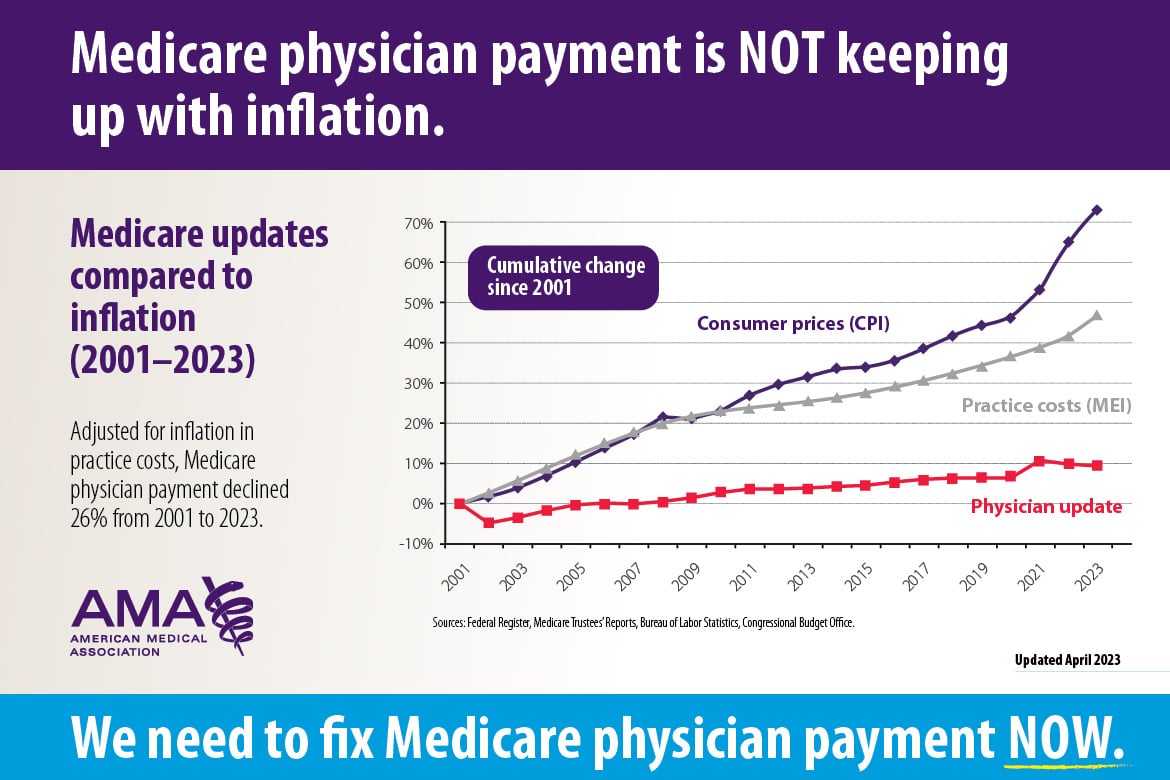What’s the news: The cost of practicing medicine is hitting a high mark for the 21st century, yet doctors are facing a 3.36% cut in pay under the proposed 2024 Medicare physician payment schedule published yesterday.
The Centers for Medicare & Medicaid Services (CMS) proposal “is a critical reminder that patients and physicians desperately need Congress to develop a permanent solution that addresses the financial instability and threatens access to care,” said AMA President Jesse M. Ehrenfeld, MD, MPH.
The pay schedule estimates the Medicare Economic Index (MEI)—the government’s measure of inflation in medical practice costs—will hit 4.5%, which comes on top of 2023’s 3.8% rise.
“In the face of these growing costs of running a medical practice, physicians have faced the COVID pandemic and increased inflation. Not only have Medicare payments failed to respond, but physicians saw a 2% payment reduction for 2023, creating an additional challenge at a perilous moment,” Dr. Ehrenfeld noted.
Learn about how you can take part in the fight to fix Medicare on behalf of your patients and practices at the AMA's Fix Medicare Now website.
Leading the charge to reform Medicare pay is the first pillar of the AMA Recovery Plan for America’s Physicians.
The AMA has challenged Congress to work on systemic reforms and make Medicare work better for you and your patients. Our work will continue, fighting tirelessly against future cuts—and against all barriers to patient care.
Why it’s important: Medicare physician payment effectively declined (PDF) 26% from 2001 to 2023, even before additional inflation and these cuts are accounted for.
Doctors have seen “seven lean years that include a pandemic and rampaging inflation,” Dr. Ehrenfeld said. “Physicians need relief from this unsustainable journey.”
It’s widely acknowledged by the experts that chronically inadequate Medicare payment rates will eventually take a toll on older adults’ access to high-quality care.
“These increasingly thin or negative operating margins disproportionately affect small, independent, and rural physician practices, as well as those treating low-income or other historically minoritized or marginalized patient communities,” Dr. Ehrenfeld said. “Piling on more cuts is an unsustainable approach. Congress needs to turn its attention to fixing Medicare so we can preserve access for patients.”
Fortunately, Dr. Ehrenfeld said, “momentum is building for reform,” noting that the Medicare Payment Advisory Commission in January recommended for the first time that a physician payment update be tied to the MEI.
Then in the spring, a bill was introduced in Congress to tie the Medicare physician payment schedule to MEI. The bipartisan bill—H.R. 2474, the Strengthening Medicare for Patients and Providers Act—was introduced by California Democratic Reps. Raul Ruiz, MD, and Ami Bera, MD, along with Republicans Larry Bucshon, MD, of Indiana, and Mariannette Miller-Meeks, MD, of Iowa. The legislative effort could put Congress on the path to finally reforming the outdated Medicare payment system.
While the AMA’s experts are still analyzing the nearly 2,000-page proposed rule from the CMS in detail, another notable point is that CMS is proposing to increase the performance threshold to avoid a penalty in the Merit-based Incentive Payment System (MIPS) from 75 points to 82 points.
CMS estimates this would result in an increase in the number of MIPS eligible clinicians who would receive a penalty of up to negative 9%. The AMA will strongly oppose increasing the threshold and is alarmed that CMS would propose an increase that results in significantly more physicians being penalized by MIPS, as the program has been largely paused since 2019 due to the significant disruptions caused by the COVID-19 pandemic.
Research (PDF) continues to show that MIPS is:
- Unduly burdensome. Disproportionately harmful to small, rural and independent practices.
- Exacerbating health inequities.
- Divorced from meaningful clinical outcomes.
The AMA is also urging (PDF) Congress to make statutory changes to improve MIPS and address these fundamental problems with the program.
Learn more: The AMA has declared Medicare physician payment reform to be an urgent advocacy and legislative priority. To help physician advocates and lawmakers get a stronger grasp on the complicated terrain of Medicare physician payment reform, the AMA has developed a series of additional explainers that outline problems with the issues mentioned above and offer solutions:
- The Medicare Economic Index (PDF).
- Medicare physician payment adequacy: Budget neutrality (PDF).
- Merit-based Incentive Payment System (PDF).
- Advancing value-based care with alternative payment models (PDF).
- Transitioning to value-based care: Clinical data registries (PDF).
Visit AMA Advocacy in Action to find out what’s at stake in reforming Medicare payment and other advocacy priorities the AMA is actively working on.





